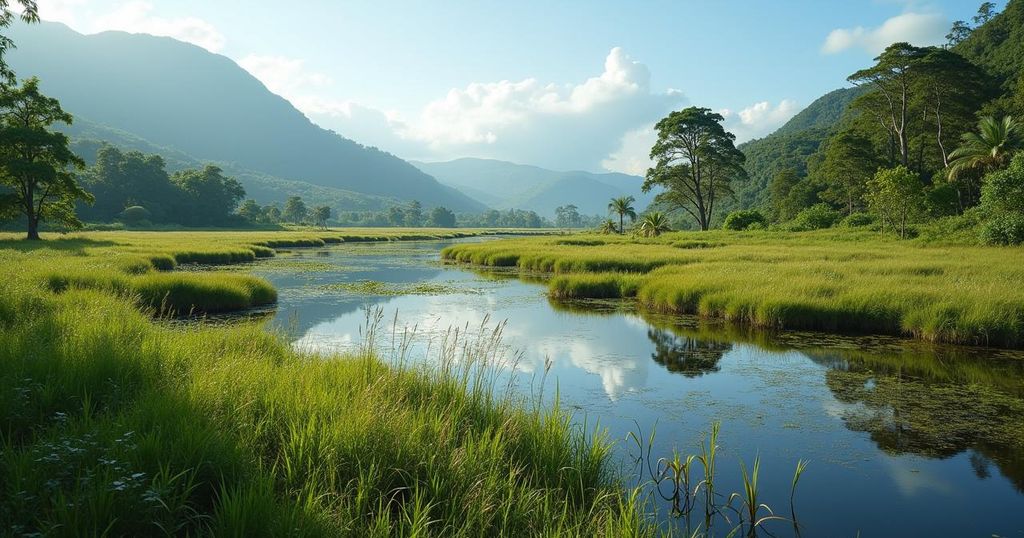Conservation Efforts Amidst Water Crisis: The Fight to Protect Colombia and Ecuador’s Vital Wetlands

Rural communities in Colombia and Ecuador are mobilizing to protect high-altitude wetlands known as paramos, critical for regulating water cycles as both nations face severe drought due to El Niño and climate change. Grassroots activists, supported by international organizations, are restoring native plant species to enhance water conservation, while local efforts are crucial for ensuring sustainable water supplies for cities like Bogota. The preservation of these ecosystems is essential for combating the impacts of climate change and securing agricultural futures.
In response to the ongoing water crisis in Colombia and Ecuador, rural communities within the Andean region are taking significant strides to safeguard vital high-altitude wetlands known as paramos. These ecosystems play a crucial role in regulating local hydrology, particularly as both nations endure severe drought conditions attributed to the El Niño weather phenomenon, compounded by climate change and detrimental human activities. The reliance of both countries on hydroelectric power has further intensified pressures on water resources, leading to drastic measures such as energy rationing and water restrictions, particularly evident in Colombia’s capital, Bogota, which houses nearly 10 million residents. Colombia’s energy crisis has resulted in the cessation of electricity exports to Ecuador to prioritize domestic energy needs. Grassroots initiatives, supported by international organizations like Conservation International, are focusing on the restoration of native flora to bolster the paramos’ water absorption capabilities. These wetlands, primarily found in the Andes, are essential for maintaining the water cycle; they absorb rainfall and gradually release it back into the ecosystem. “Deforestation in the Amazon, combined with variations that are being caused by climate change and the degradation of the soils is what has caused water dynamics to change,” stated Patricia Bejarano, the director of Conservation International’s Colombian sustainable high mountain landscapes program. Among the notable efforts is a nursery established by the Nature Conservancy in the Paluguillo paramo, where local women cultivate Polylepis trees, which are effective in capturing atmospheric moisture and facilitating water retention. Diana Sopalo, a 29-year-old worker at this nursery, remarked, “They’re plants native to the paramo that help us conserve water,” emphasizing their importance in regional water conservation strategies. Around 40,000 trees have been planted, with an additional 100,000 in development, reinforcing the notion of paramos as natural “water factories.” Furthermore, monitoring and protective measures are implemented by rangers, as highlighted by Galo Medina of the Nature Conservancy, who stated, “If the paramos weren’t being managed, we would simply have much less water than we have now.” In Colombia’s Guatavita region, activists and authorities are collaborating on conservation efforts at Vista Hermosa de Monquentiva in the Chingaza paramo, which has been designated a protected area since 2018. These initiatives are paramount for ensuring a sustainable supply of drinking water and maintaining hydroelectric reservoirs. Doris Ramos from the Guatavita mayor’s office noted the importance of species like frailejones, which are renowned for their water-conserving properties, in bolstering the resilience of this ecosystem against climate change.
The worsening water crisis in Colombia and Ecuador highlights the critical importance of the paramos wetlands, which are pivotal in maintaining the delicate water cycles in the Andean region. This crisis is driven by a combination of acute drought conditions, exacerbated by climate change and environmental degradation such as deforestation. Given that both nations predominantly depend on hydroelectric dams for energy generation, the degradation of wetland ecosystems poses significant challenges to water supply and energy sustainability. The local communities, therefore, are mobilizing efforts to educate and implement strategies for wetland conservation, often in partnership with international advocacy organizations, to mitigate the impacts of climate change through ecological restoration.
In conclusion, the concerted efforts of rural communities in Colombia and Ecuador to protect high-altitude wetlands are vital in addressing the ongoing water crisis exacerbated by climate change. Through grassroots initiatives, the restoration of native plant species, and collaborative monitoring, these communities not only ensure local water security but also contribute to broader environmental stability. The paramos are irreplaceable resources that require effective management to support both current and future generations amidst the challenges posed by changing climatic conditions.
Original Source: www.fastcompany.com





